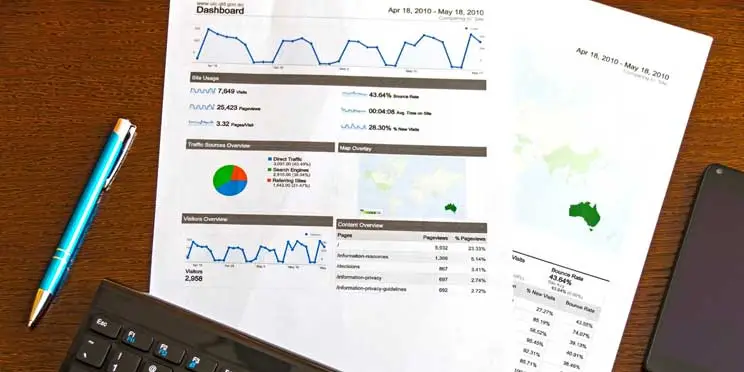Financial ratios are critical factors that must be considered by a business. Because this ratio should be used to make all kinds of decisions.
With the intention that the judgments made do not lead to misconceptions or errors in decision-making. As a result, all actions made by the organization must take financial factors into account.
The goal is for financial management to be able to foresee future events. So, what exactly do financial ratios indicate, according to experts? And what kind is it?
Definition, Function, and Type of Company Financial Ratio

Before delving into the many sorts of ratios in corporate finance, it’s important to first understand the definitions. Because you won’t be able to understand its function unless you know what it means.
1. Financial Ratios: An Introduction
Financial ratios are an analytical tool that examines financial statements during the accounting period to determine firm growth.
That manner, it will be clear whether the company’s performance is optimal or not. In corporate finance, ratios are typically used to examine all policies and actions in order to help safeguard and save assets.
Also read: Definition of Financial Statements, along with the Types and Benefits!
Of course, this is done to ensure that the organization does not make judgments that would only harm it. Until it eventually led to an unavoidable bankruptcy.
2. Corporate Financial Ratio Function
The role of the company’s financial ratios is quite important. As a result, it is critical to pay close attention, particularly when studying critical financial statement data.
Some of the functions given by the existence of ratios for businesses are as follows:
- Examination of Financial Optimization
All forms of financial statements will be read correctly with the ratio. Is it highly optimal, or are the finances being squandered?Adverse policies will be evaluated in this manner. All sorts of financial statement fraud will be visible even with financial ratios.
- Considering the Effectiveness of Operational Management
The ratio can be used to determine whether or not operational management’s funding was effective. As a result, evaluating the operational party’s performance will be simple. - Take note of how assets are used
It is also necessary to evaluate the utilization of assets. Because the total value of the company’s assets will have an impact on all of the company’s policies.In other words, if the company’s assets are not employed optimally, the policy that will be decided will fail.
- Examining Financial Health
The care paid to the company’s development can be observed in its financial health. As a reader of the company’s age study, this necessitates financial ratios.Will the business survive, or will it go bankrupt? All of these decisions are heavily influenced by their financial situation.
- Analyzing the Company’s Growth Path
Business growth is required for a company travel, such as developing marketing areas, adding branches, and producing new items.To accomplish this, it is necessary to conduct an analysis of the ratios in the company’s finances in order for it to run smoothly. So that it does not make the wrong decision.
After understanding the definition and function of a firm ratio. Now is the time to learn about the different sorts in the following discussion.
Also read: How to Prepare a Simple Income Statement
3. Different Types of Company Financial Ratios
The sorts of company ratios encompass a variety of topics in accordance with their purpose as financial analysis. Here are some examples of ratios you should be familiar with:
- Profit Ratio
In this area, you can see how much profit the company makes. As a result, the profit ratio will be used to guide the development and optimization of all corporate activities. - Short-Term Debt Ratio
This ratio function is used to assess a company’s ability to repay its short-term debt. If the ratio reveals a significant amount of debt, the company’s financial health is in jeopardy.If the debt ratio appears to be quite high, the period for the company’s bankruptcy can be determined. As a result, the short-term debt ratio must be calculated on a regular basis.
- Debt Ratio
This type of ratio’s role will provide an analysis of the company’s ability to pay off all of its debts. There is both short-term and long-term debt.If the ratio is high enough, investors will feel comfortable putting their money into the company. Because investors believe that their capital is assured to be safe.
- Activity Ratio
This ratio’s purpose is to assess the company’s ability to make profits. The trick is to pay attention to the company’s assets during the manufacturing process.Using this ratio analysis, you may quickly determine whether or not the company’s assets are effective.
Also read: 5 Easy and Fast Ways to Create Ledgers
These are the four sorts of financial ratios in a business. After reading the above explanation, you should have a better understanding of the significance of ratios in business. That necessitates the use of a formula to compute it.
Formulas for Calculating Financial Ratios

Following the preceding information, you must understand the approach or formula that can be utilized to generate ratios in corporate finances. The following formula is used to determine the amount of the ratio based on its type:
1. Profit Ratio
- Approach to Calculating Percentage Gross Profit
The total gross profit ratio is calculated using this formula. Is the amount too much or too low? Because a high gross profit ratio indicates the company’s financial soundness.Gross profit / sales is the formula.
- Using the Operating Profit Approach to Calculate Profit Ratios
This formula can be used to calculate the operational profit ratio of a corporation. The effectiveness of sales on sales profit will be plainly obvious as a result of this. - Using the Net Profit Approach to Calculate Profit Ratios
This technique of calculation is fairly straightforward, including the use of the formula net profit divided by sales. - Using ROA (Return on Assets) to Calculate Profit Ratio
The formula for calculating net income using ROA is net income divided by total assets. - Using ROI (Return on Investment) to Calculate Profit Ratio
The formula for calculating net income using ROA is net income divided by investment value.
2. Short Term Debt Ratio
- Fast Ratio Calculation
This formula is used to calculate the company’s ability to pay off all of its debts. Current assets minus inventory divided by current liabilities x 100 percent is the formula. - Calculating Current Ratio
This formula is used to calculate the company’s capacity to pay its present liabilities. Current assets divided by current liabilities is the formula. - Calculating Cash Ratios
This formula is used to calculate the cash-to-current-assets ratio. Cash + cash equivalent assets / current liabilities x 100 percent
3. Debt to Income Ratio
- Using the Asset Approach to Calculate Debt Ratio
This formula is used to calculate the fund analysis. The larger the company’s financial value, the lower the percentage of outcomes held. The equation is Total debt divided by total assets multiplied by 100% - Using the Capital Approach to Calculate Debt Ratio
This formula is used to calculate the debt-to-equity ratio. The larger the company’s financial value, the lower the percentage of outcomes held. The formula is the amount of debt divided by the capital value.
4. Activity Ratio
- Using Accounts Receivable Turnover to Calculate Activity Ratio
Total Receivables divided by average receivables is the formula for calculating the ratio of activity through receivables turnover. - Using Fixed Asset Turnover to Calculate Activity Ratio
Sales divided by fixed assets/li> is the formula for calculating the activity ratio through fixed asset turnover. - Using the Inventory Method to Calculate Activity Ratio
The cost of goods sold divided by inventory formula can be used to compute the activity ratio using the inventory approach. - Calculating Activity Ratio Using Total Asset Turnover
Sales divided by total assets is the formula for calculating the activity ratio via total asset turnover.
Start Using SAP Business One Right Now!
That concluded the discussion of the definition, function, and several forms of firm financial ratios. Use SAP Business One from PT. Sterling Sincerely Brilliant if you need the best program to compute financial ratios. For further information, please see the website listed below!


